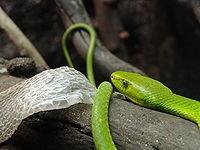- Eastern green mamba
-
Eastern green mamba 
Scientific classification Kingdom: Animalia Phylum: Chordata Subphylum: Vertebrata Class: Reptilia Order: Squamata Suborder: Serpentes Family: Elapidae Genus: Dendroaspis Species: D. angusticeps Binomial name Dendroaspis angusticeps
(A. Smith, 1849)[1]The Eastern green mamba (Dendroaspis angusticeps) is a medium to large arboreal highly venomous snake of the family Elapidae.
Contents
Description
The eastern green mamba is overall glossy green in colour with a lighter bright greenish-yellow belly. This is the smallest Mamba (dendroaspis) species, averaging only 1.4 metres (4.6 ft) in length.[2][3] The maximum size for this species is 2.4 metres (7.9 ft), but this is uncommon.[4][5] Male eastern green mambas are generally slightly larger than females.[6] The species has two enlarged venom fangs fixed to the front of the mouth and solid teeth in both jaws. It has very smooth scales, is thin and elegant with a very distinctive head that is long and rectangular and they have a long thin tail. Their eyes are are medium in size with round pupils. Dorsal scales are oblique, smooth and narrow. Dorsal scale count usually 25 - ( 21 or 23 ) - ( 15 to 19 ).[4] Eastern green mamba hatchlings have a yellowish-green color.[2]
Geographic range
This species is indigenous to the east coast of southern Africa and occurs throughout much of eastern Africa.[3] It is found near the coast stretching from western South Africa through to Mozambique, Tanzania, Swaziland, and as far as south-east Kenya, going inland as far as southern Malawi and eastern Zimbabwe.[6][4]
Habitat
Eastern green mamba's are an arboreal species and thus are almost always found in trees. Very rarely are they found on the ground unless driven by prey or for their need to bask under the sun. They are not usually found in open terrain.[4] Thickly forested and bush-covered areas such as evergreen forests, mainly make for this species' habitat. They can also be found in regions like coastal scrub, woodland, moist savanna, bamboo and mango plantations. The species can even be found in dense montane forest up to about 1,700 metres (5,600 ft) above sea level. They're often found in thickets and farm trees (citrus, cashew nut, coconut and mango) which offer plenty of shade. In coastal east Africa it is known to enter houses and often shelters in thatched roof dwellings.[4] They may even be found in tropical or sub-tropical regions within their range.[3][6][2]
Behaviour and Diet
This species is highly arboreal and seldom ventures to the ground unless following prey or to bask under the sun. Unlike its much larger cousin the Black mamba, this mamba is very shy and generally not too aggressive. It will avoid confrontation with humans or other potential predators when possible. They are fast snakes, capable of moving 7 mph. They don't always strike, but under continuous harassment and provocation and especially if cornered, they may suddenly become very ferocious and strike repeatedly in quick succession.[7]
They are a diurnal species that hunt during the day. The diet of the Eastern green mamba consists primarily of adult and juvenile birds, bird eggs, frogs, lizards, rodents, and other small mammals. They will hunt on the ground if suitable prey cannot be found in the trees. Young specimens will occasionally eat other reptiles, such as chameleons.[7]
Reproduction
The eastern green mamba is solitary, except during mating. Males find females by following a scent trail. Male eastern green mambas will compete with other males with a ritual dance or wrestling contest on the ground, in which one male tries to force the other down. These combats may last for several hours. Combat does not include biting. Courtship and mating take place in the trees, after which the female lays between 6-17 eggs (average of 10-15 eggs are usually layed).[7] The eggs are usually laid in a hollow tree among decaying vegetation. After a little over three months, the young mambas hatch and are between 35 and 45 cm (13 to 18 inches) in length and are venomous from birth. This species can live up to 15-25 years, and 14 years if kept in captivity.[3]
Venom
The eastern green mamba is a very venomous snake. The venom consists mainly of neurotoxins, cardiotoxins, calcicludine, and fasciculins. The average venom yield per bite is 60-95 mg (Minton, 1974),[4] while the subcutaneous LD50 ranges from 0.26 mg/kg to 3.05 mg/kg. Like all other Mamba species, the toxicity of individual specimens within the same species and subspecies can vary greatly based on several factors including geographical region and even the weather and altitude (Ernst and Zug et al. 1996). Local swelling is variable and sometimes absent after mamba bites. However, patients bitten by the eastern green mamba develop swelling of the entire bitten limb and also show mild haemostatic disturbances (Warrell DA; MacKay et al. 1966). The rare cases of local tissue damage usually resulted from bites on the fingers or the use of a tight tourniquet.[5] This species has caused fatalities among bitten humans. The mortality rate of untreated bites is unknown but is thought to be high.[4]
Photos
References
- ^ Reptile Database. www.reptile-database.org.
- ^ a b c Zug, George R. (1996). Snakes in Question: The Smithsonian Answer Book. Washington D.C., USA: Smithsonian Institution Scholarly Press. ISBN 1560986484.
- ^ a b c d WhoZoo.org - Eastern green mamba
- ^ a b c d e f g [http://www.toxinology.com/fusebox.cfm fuseaction=main.snakes.display&id=SN0168 WCH Clinical Toxinology Resources (Dendroaspis angusticeps)
- ^ a b WHO - Guidelines for the Prevention and Clinical Management of Snakebite in Africa
- ^ a b c Eastern green mamba (Dendroaspis angusticeps) Info
- ^ a b c O'Shea, Mark (12 September). Venomous Snakes of the World. New Jersey, USA: Princeton University Press. ISBN 0691124361.
- Smith, A. 1849. Illustrations of the zoology of South Africa. Reptilia. Smith, Elder & Co. London.
External links
Categories:- Elapidae
- Reptiles of Africa
Wikimedia Foundation. 2010.


